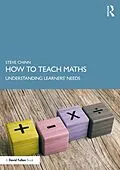How to Teach Maths challenges everything you thought you knew about how maths is taught in classrooms. Award-winning author Steve Chinn casts a critical eye over many of the long-established methods and beliefs of maths teaching. Drawing from decades of classroom experience and research, he shows how mathematics teaching across the whole ability range can be radically improved by learning from the successful methods and principles used for the bottom quartile of achievers: the outliers. Chinn guides readers through re-adjusting the presentation of maths to learners, considering learners' needs first, and explains the importance of securing early learning to create a conceptual foundation for later success.
This highly accessible book uses clear diagrams and examples to support maths teachers through many critical issues, including the following:
- The context of maths education today
- Topics that cause students the most difficulty
- Effective communication in the mathematics classroom
- Addressing maths anxiety
The perfect resource for maths teachers at all levels, this book is especially useful for those wanting to teach the foundations of mathematics in a developmental way to learners of all ages and abilities. It has the potential to change the way maths is taught forever.
Autorentext
Steve Chinn is a Visiting Professor at the University of Derby. He is the author of The Trouble with Maths and More Trouble with Maths and the editor of The Routledge International Handbook of Dyscalculia and Mathematical Learning Difficulties. He has lectured and provided teacher training in over 30 countries. He founded, and ran for two decades, an award-winning school for learners with specific learning difficulties.
Klappentext
How to Teach Maths challenges everything you thought you knew about how maths is taught in classrooms. Award-winning author Steve Chinn casts a critical eye over many of the long-established methods and beliefs of maths teaching. Drawing from decades of classroom experience and research, he shows how mathematics teaching across the whole ability range can be radically improved by learning from the successful methods and principles used for the bottom quartile of achievers: the outliers. Chinn guides readers through re-adjusting the presentation of maths to learners, considering learners' needs first, and explains the importance of securing early learning to create a conceptual foundation for later success.
This highly accessible book uses clear diagrams and examples to support maths teachers through many critical issues, including the following:
- The context of maths education today
- Topics that cause students the most difficulty
- Effective communication in the mathematics classroom
- Addressing maths anxiety
The perfect resource for maths teachers at all levels, this book is especially useful for those wanting to teach the foundations of mathematics in a developmental way to learners of all ages and abilities. It has the potential to change the way maths is taught forever.
Inhalt
Introduction
Chapter 1 Where we are with maths education
Chapter 2 Key identifiers of future and current maths difficulties
Chapter 3 The core curriculum for arithmetic
Chapter 4 The developmental nature of maths
Chapter 5 Topics which cause the most difficulty
Chapter 6 Learner characteristics and key skills
Chapter 7 Meta-cognition
Chapter 8 Linking facts and concepts
Chapter 9 The role of language, vocabulary and symbols: Communication and perspectives on communication
Chapter 10 The inconsistencies of maths and their impact on learning
Chapter 11 How to use materials and visual images
Chapter 12 Two visual methods
Chapter 13 Anxiety and withdrawal
Chapter 14 Assessment and diagnosis of mathematical difficulties
Chapter 15 Classroom management
Chapter 16 Bringing it all together
Appendix 1 What an 11-year-old is expected to know
Appendix 2 Books and resources
